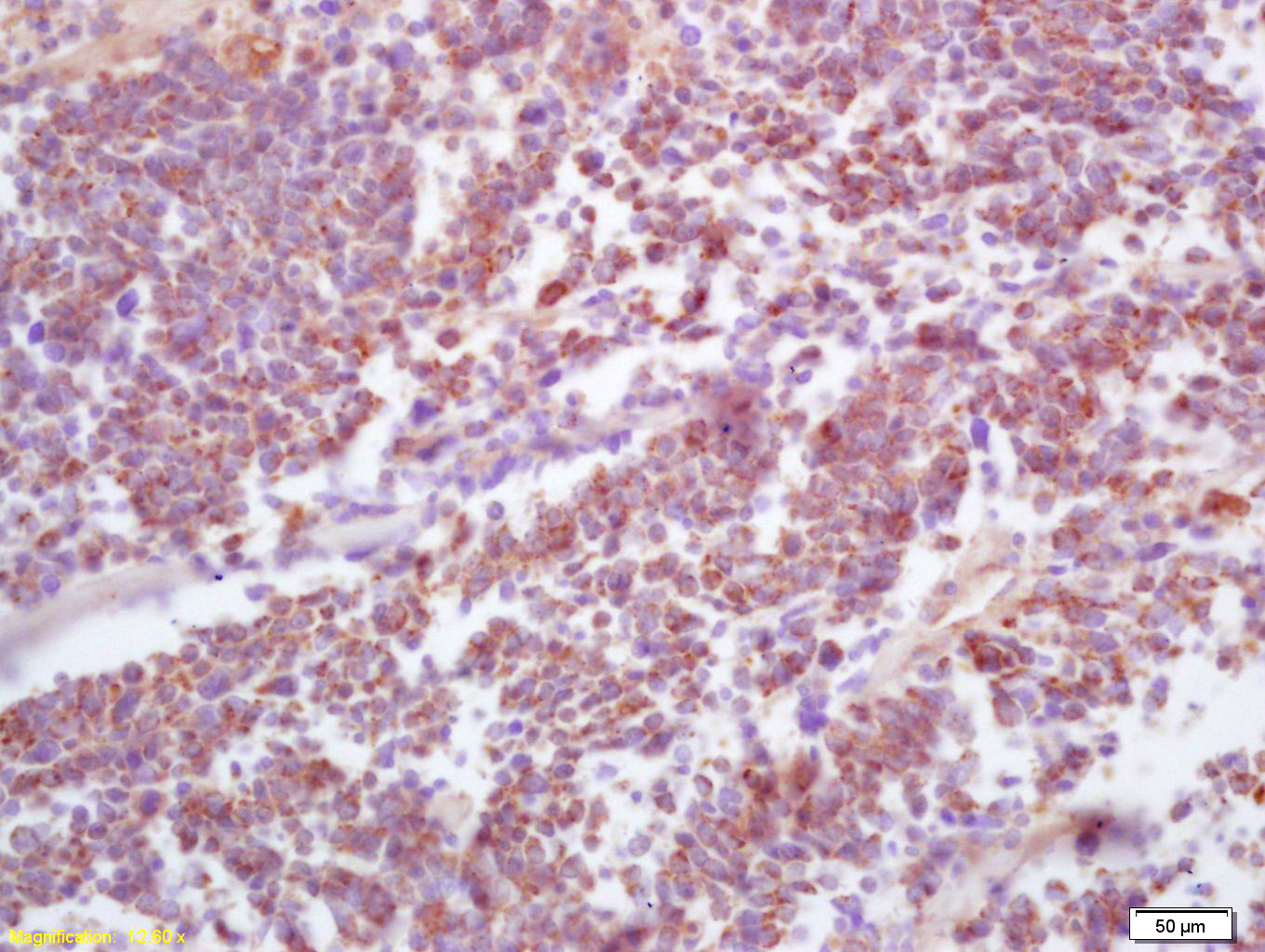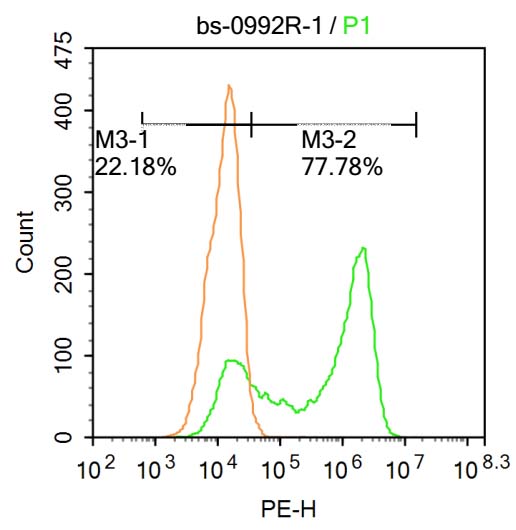
Rabbit Anti-HPV16 E7 antibody
E7; HPV16 E7 protein; Human Papilloma Virus; Human papillomavirus type 16 E7; Human papillomavirus type 16 E7; Protein E7; Human Papillomavirus 16 (E7); HPV16 E7; E7 protein (HPV16); VE7_HPV16; HPV16-E7.
View History [Clear]
Details
Product Name HPV16 E7 Chinese Name 人类乳头状瘤病毒16-E7抗体 Alias E7; HPV16 E7 protein; Human Papilloma Virus; Human papillomavirus type 16 E7; Human papillomavirus type 16 E7; Protein E7; Human Papillomavirus 16 (E7); HPV16 E7; E7 protein (HPV16); VE7_HPV16; HPV16-E7. Research Area Tumour immunology Bacteria and viruses Immunogen Species Rabbit Clonality Polyclonal Applications IHC-P=1:100-500 IHC-F=1:100-500 Flow-Cyt=1ug/Test (Paraffin sections need antigen repair)
not yet tested in other applications.
optimal dilutions/concentrations should be determined by the end user.Theoretical molecular weight 11kDa Form Liquid Concentration 1mg/ml immunogen KLH conjugated synthetic peptide derived from the middle of HPV16-E7: 21-98/98 Lsotype IgG Purification affinity purified by Protein A Buffer Solution 0.01M TBS(pH7.4) with 1% BSA, 0.03% Proclin300 and 50% Glycerol. Storage Shipped at 4℃. Store at -20 °C for one year. Avoid repeated freeze/thaw cycles. Attention This product as supplied is intended for research use only, not for use in human, therapeutic or diagnostic applications. PubMed PubMed Product Detail Human papilloma viruses (HPVs) can be classified as either high risk or low risk according to their association with cancer. HPV16 and HPV18 are the most common of the high risk group while HPV6 and HPV11 are among the low risk types. Approximately 90% of cervical cancers contain HPV DNA of the high risk types. Mutational analysis have shown that the E6 and E7 genes of the high risk HPVs are necessary and sufficient for HPV transforming function. The specific interactions of the E6 and E7 proteins with p53 and pRB, respectively, correlate with HPV high and low risk classifications. The high risk HPV E7 proteins bind to pRB with a higher affinity than do the low risk HPV proteins, and only the high risk HPV E6 proteins form detectable complexes with p53 in vitro.
Function:
E7 protein has both transforming and trans-activating activities. Disrupts the function of host retinoblastoma protein RB1/pRb, which is a key regulator of the cell cycle. Induces the disassembly of the E2F1 transcription factors from RB1, with subsequent transcriptional activation of E2F1-regulated S-phase genes. Inactivation of the ability of RB1 to arrest the cell cycle is critical for cellular transformation, uncontrolled cellular growth and proliferation induced by viral infection. Stimulation of progression from G1 to S phase allows the virus to efficiently use the cellular DNA replicating machinery to achieve viral genome replication. Interferes with histone deacetylation mediated by HDAC1 and HDAC2, leading to activation of transcription (By similarity).
Subunit:
Homodimer. Homooligomer. Interaction with host RB1 induces the aberrant dissociation of RB1-E2F1 complex thereby disrupting RB1's activity. Binds to CHD3 through its zinc-finger domain. Forms a complex with CHD3 and HDAC1, thereby altering the action of host histone deacetylation. A similar complex involving E7, CHD3 and HDAC2 might also form. Interacts with E2; this interaction inhibits E7 oncogenic activity.
Similarity:
Belongs to the papillomaviridae E7 protein family.
SWISS:
P03129
Gene ID:
1489079
Database links:
Entrez Gene: 1489079 HPV16
SwissProt: P03129 HPV16
人类乳头状瘤病毒16(HPV16-E7)是导致女性宫颈癌的主要病毒型(包括人类乳头状瘤病毒18Product Picture
Antigen retrieval: citrate buffer ( 0.01M, pH 6.0 ), Boiling bathing for 15min; Block endogenous peroxidase by 3% Hydrogen peroxide for 30min; Blocking buffer (normal goat serum,C-0005) at 37℃ for 20 min;
Incubation: Anti-HPV16-E7 Polyclonal Antibody, Unconjugated(SL0992R) 1:200, overnight at 4°C, followed by conjugation to the secondary antibody(SP-0023) and DAB(C-0010) staining
Blank control: Hela.
Primary Antibody (green line): Rabbit Anti-HPV16 E7 antibody (SL0992R)
Dilution: 1μg /10^6 cells;
Isotype Control Antibody (orange line): Rabbit IgG .
Secondary Antibody : Goat anti-rabbit IgG-PE
Dilution: 1μg /test.
Protocol
The cells were fixed with 4% PFA (10min at room temperature)and then permeabilized with 90% ice-cold methanol for 20 min at-20℃. The cells were then incubated in 5%BSA to block non-specific protein-protein interactions for 30 min at at room temperature .Cells stained with Primary Antibody for 30 min at room temperature. The secondary antibody used for 40 min at room temperature. Acquisition of 20,000 events was performed.
Bought notes(bought amounts latest0)
No one bought this product
User Comment(Total0User Comment Num)
- No comment




 +86 571 56623320
+86 571 56623320
 +86 18668110335
+86 18668110335

